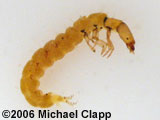
THE XERCES SOCIETY FOR INVERTEBRATE CONSERVATION Aquatic Invertebrates in Pacific Northwest Freshwater Wetlands |
| Identify taxa |
The Philopotamidae build finger-like nets on the underside of rocks. They use the nets as shelter and to efficiently filter organic particles from the water. They are common and sometimes abundant in stream samples, but are not commonly encountered in wetlands. Live specimens are yellow and wiggle actively through the water column; preserved specimens turn white. Philopotamidae have the well developed anal prolegs typical of free-living caddisfly families. Only the first thoracic segment is covered by a plate. Their most distinctive character is a pale, fleshy,T-shaped labrum at the front of their head above their mandibles. They use this labrum to collect food from the inside of their net. |
Size: medium to large Images on this page are from www.nwnature.net, and were used with permission from Michael Clapp. |
Resources |
© 2007 Xerces Society
Contact info@xerces.org

